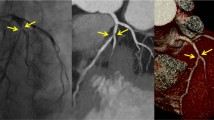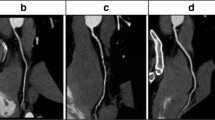Abstract
This prospective study evaluated the image quality and accuracy of coronary computed tomography angiography (CCTA) for diagnosing coronary artery disease (CAD) in patients with atrial fibrillation (AF), in which CCTA used adaptive iterative dose reduction (AIDR) with a low tube voltage and low concentration of isotonic contrast agent. Sixty-eight consecutive patients with AF and suspected CAD were equally and randomly apportioned to two groups and underwent CCTA. In the experimental group, the contrast agent was iodixanol (270 mg I/mL), patients were scanned with 100 kV, and reconstruction was by AIDR. In the conventional scanning (control) group, the contrast agent was iopromide (370 mg I/mL), patients were scanned with 120 kV, and reconstruction was by filtered back projection. The image quality, effective radiation dose (E), and total iodine intake of the groups were compared. Thirty-nine patients with coronary artery stenosis later were given invasive coronary angiography (ICA). The groups were similar with regard to mean CT value, noise, and signal-to-noise and contrast-to-noise ratios. The figure of merit of the experimental group was significantly higher than that of the control group, while the E and total iodine were significantly lower. Using ICA as the diagnostic reference, the groups shared similar sensitivity, specificity, and false positive and false negative rates for diagnosing coronary artery stenosis. For determining CAD in patients with AF, CCTA with isotonic low-concentration contrast agent and low-voltage scanning is a feasible alternative that improves accuracy and reduces radiation dose and iodine intake.



Similar content being viewed by others
References
Sun Z, Jiang W (2006) Diagnostic value of multislice computed tomography angiography in coronary artery disease: a meta-analysis. Eur J Radiol 60:279–286
Tsiflikas I, Drosch T, Brodoefel H et al (2010) Diagnostic accuracy and image quality of cardiac dual-source computed tomography in patients with arrhythmia. Int J Cardiol 143:79–85
Nucifora G, Schuijf JD, Tops LF et al (2009) Prevalence of coronary artery disease assessed by multislice computed tomography coronary angiography in patients with paroxysmal or persistent atrial fibrillation. Circ Cardiovasc Imaging 2:100–106
Fuster V, Ryden LE, Cannom DS et al (2011) 2011 ACCF/AHA/HRS focused updates incorporated into the ACC/AHA/ESC 2006 guidelines for the management of patients with atrial fibrillation: a report of the American College of Cardiology Foundation/American Heart Association Task Force on practice guidelines. Circulation 123:e269–e367
Clayton B, Roobottom C, Morgan-Hughes G (2015) CT coronary angiography in atrial fibrillation: a comparison of radiation dose and diagnostic confidence with retrospective gating vs prospective gating with systolic acquisition. Br J Radiol 88:20150533
Srichai MB, Barreto M, Lim RP, Donnino R, Babb JS, Jacobs JE (2013) Prospective-triggered sequential dual-source end-systolic coronary CT angiography for patients with atrial fibrillation: a feasibility study. J Cardiovasc Comput Tomogr 7:102–109
Wang Q, Qin J, He B, Zhou Y, Yang JJ, Hou XL, Yang XB, Chen JH, Chen YD (2013) Computed tomography coronary angiography with a consistent dose below 2 mSv using double prospectively ECG-triggered high-pitch spiral acquisition in patients with atrial fibrillation: initial experience. Int J Cardiovasc Imaging 29:1341–1349
Xu L, Yang L, Zhang Z, Wang Y, Jin Z, Zhang L, Lu G (2013) Prospectively ECG-triggered sequential dual-source coronary CT angiography in patients with atrial fibrillation: comparison with retrospectively ECG-gated helical CT. Eur Radiol 23:1822–1828
Vorre MM, Abdulla J (2013) Diagnostic accuracy and radiation dose of CT coronary angiography in atrial fibrillation: systematic review and meta-analysis. Radiology 267:376–386
Oda S, Honda K, Yoshimura A et al (2016) 256-Slice coronary computed tomographic angiography in patients with atrial fibrillation: optimal reconstruction phase and image quality. Eur Radiol 26:55–63
Dewey M, Zimmermann E, Deissenrieder F, Laule M, Dubel HP, Schlattmann P, Knebel F, Rutsch W, Hamm B (2009) Noninvasive coronary angiography by 320-row computed tomography with lower radiation exposure and maintained diagnostic accuracy: comparison of results with cardiac catheterization in a head-to-head pilot investigation. Circulation 120:867–875
Kondo T, Kumamaru KK, Fujimoto S, Matsutani H, Sano T, Takase S, Rybicki FJ (2013) Prospective ECG-gated coronary 320-MDCT angiography with absolute acquisition delay strategy for patients with persistent atrial fibrillation. Am J Roentgenol 201:1197–1203
Korhonen M, Parkkonen J, Hedman M, Muuronen A, Onatsu J, Mustonen P, Vanninen R, Taina M (2017) Morphological features of the left atrial appendage in consecutive coronary computed tomography angiography patients with and without atrial fibrillation. PLoS ONE 12:e0173703
Rybicki FJ, Otero HJ, Steigner ML et al (2008) Initial evaluation of coronary images from 320-detector row computed tomography. Int J Cardiovasc Imaging 24:535–546
Pasricha SS, Nandurkar D, Seneviratne SK, Cameron JD, Crossett M, Schneider-Kolsky ME, Troupis JM (2009) Image quality of coronary 320-MDCT in patients with atrial fibrillation: initial experience. Am J Roentgenol 193:1514–1521
Hoe J, Toh KH (2009) First experience with 320-row multidetector CT coronary angiography scanning with prospective electrocardiogram gating to reduce radiation dose. J Cardiovasc Comput Tomogr 3:257–261
Slovis TL (2002) The ALARA concept in pediatric CT: myth or reality? Radiology 223:5–6
Di Cesare E, Gennarelli A, Di Sibio A, Felli V, Splendiani A, Gravina GL, Barile A, Masciocchi C (2014) Assessment of dose exposure and image quality in coronary angiography performed by 640-slice CT: a comparison between adaptive iterative and filtered back-projection algorithm by propensity analysis. Radiol Med 119:642–649
Yoo RE, Park EA, Lee W, Shim H, Kim YK, Chung JW, Park JH (2013) Image quality of adaptive iterative dose reduction 3D of coronary CT angiography of 640-slice CT: comparison with filtered back-projection. Int J Cardiovasc Imaging 29:669–676
Oda S, Utsunomiya D, Funama Y, Awai K, Katahira K, Nakaura T, Yanaga Y, Namimoto T, Yamashita Y (2011) A low tube voltage technique reduces the radiation dose at retrospective ECG-gated cardiac computed tomography for anatomical and functional analyses. Acad Radiol 18:991–999
Pan YN, Li AJ, Chen XM, Wang J, Ren DW, Huang QL (2016) Coronary computed tomographic angiography at low concentration of contrast agent and low tube voltage in patients with obesity: a feasibility study. Acad Radiol 23:438–445
Wu Q, Wang Y, Kai H, Wang T, Tang X, Wang X, Pan C (2016) Application of 80-kVp tube voltage, low-concentration contrast agent and iterative reconstruction in coronary CT angiography: evaluation of image quality and radiation dose. Int J Clin Pract 70(Suppl 9B):B50–B55
Zhang C, Yu Y, Zhang Z, Wang Q, Zheng L, Feng Y, Zhou Z, Zhang G, Li K (2015) Imaging quality evaluation of low tube voltage coronary CT angiography using low concentration contrast medium. PLoS ONE 10:e0120539
Austen WG, Edwards JE, Frye RL, Gensini GG, Gott VL, Griffith LS, McGoon DC, Murphy ML, Roe BB (1975) A reporting system on patients evaluated for coronary artery disease. Report of the Ad Hoc Committee for Grading of Coronary Artery Disease, Council on Cardiovascular Surgery, American Heart Association. Circulation 51:5–40
Shuman WP, Branch KR, May JM, Mitsumori LM, Lockhart DW, Dubinsky TJ, Warren BH, Caldwell JH (2008) Prospective versus retrospective ECG gating for 64-detector CT of the coronary arteries: comparison of image quality and patient radiation dose. Radiology 248:431–437
Cury RC, Abbara S, Achenbach S et al (2016) CAD-RADS(TM) Coronary artery disease—reporting and data system. An expert consensus document of the Society of Cardiovascular Computed Tomography (SCCT), the American College of Radiology (ACR) and the North American Society for Cardiovascular Imaging (NASCI). Endorsed by the American College of Cardiology. J Cardiovasc Comput Tomogr 10:269–281
Ahmadi N, Nabavi V, Hajsadeghi F, Flores F, French WJ, Mao SS, Shavelle D, Ebrahimi R, Budoff M (2011) Mortality incidence of patients with non-obstructive coronary artery disease diagnosed by computed tomography angiography. Am J Cardiol 107:10–16
Zhao Y, Tao Z, Xu Z et al (2011) Toxic effects of a high dose of non-ionic iodinated contrast media on renal glomerular and aortic endothelial cells in aged rats in vivo. Toxicol Lett 202:253–260
Xue X, Jiang L, Duenninger E, Muenzel M, Guan S, Fazakas A, Cheng F, Illnitzky J, Keil T, Yu J (2018) Impact of chronic kidney disease on Watchman implantation: experience with 300 consecutive left atrial appendage closures at a single center. Heart Vessels 33:1068–1075
Cademartiri F, Mollet NR, van der Lugt A, McFadden EP, Stijnen T, de Feyter PJ, Krestin GP (2005) Intravenous contrast material administration at helical 16-detector row CT coronary angiography: effect of iodine concentration on vascular attenuation. Radiology 236:661–665
Neefjes LA, Dharampal AS, Rossi A et al (2011) Image quality and radiation exposure using different low-dose scan protocols in dual-source CT coronary angiography: randomized study. Radiology 261:779–786
Wang R, Schoepf UJ, Wu R, Reddy RP, Zhang C, Yu W, Liu Y, Zhang Z (2012) Image quality and radiation dose of low dose coronary CT angiography in obese patients: sinogram affirmed iterative reconstruction versus filtered back projection. Eur J Radiol 81:3141–3145
Leber AW, Becker A, Knez A et al (2006) Accuracy of 64-slice computed tomography to classify and quantify plaque volumes in the proximal coronary system: a comparative study using intravascular ultrasound. J Am Coll Cardiol 47:672–677
Yamamuro M, Tadamura E, Kanao S, Wu YW, Tambara K, Komeda M, Toma M, Kimura T, Kita T, Togashi K (2007) Coronary angiography by 64-detector row computed tomography using low dose of contrast material with saline chaser: influence of total injection volume on vessel attenuation. J Comput Assist Tomogr 31:272–280
Xu L, Yang L, Fan Z, Yu W, Lv B, Zhang Z (2011) Diagnostic performance of 320-detector CT coronary angiography in patients with atrial fibrillation: preliminary results. Eur Radiol 21:936–943
Schindera ST, Nelson RC, Mukundan S Jr, Paulson EK, Jaffe TA, Miller CM, DeLong DM, Kawaji K, Yoshizumi TT, Samei E (2008) Hypervascular liver tumors: low tube voltage, high tube current multi-detector row CT for enhanced detection—phantom study. Radiology 246:125–132
Zhang WL, Li M, Zhang B, Geng HY, Liang YQ, Xu K, Li SB (2013) CT angiography of the head-and-neck vessels acquired with low tube voltage, low iodine, and iterative image reconstruction: clinical evaluation of radiation dose and image quality. PLoS ONE 8:e81486
Hara AK, Paden RG, Silva AC, Kujak JL, Lawder HJ, Pavlicek W (2009) Iterative reconstruction technique for reducing body radiation dose at CT: feasibility study. Am J Roentgenol 193:764–771
Moscariello A, Takx RA, Schoepf UJ et al (2011) Coronary CT angiography: image quality, diagnostic accuracy, and potential for radiation dose reduction using a novel iterative image reconstruction technique-comparison with traditional filtered back projection. Eur Radiol 21:2130–2138
Rist C, Johnson TR, Muller-Starck J et al (2009) Noninvasive coronary angiography using dual-source computed tomography in patients with atrial fibrillation. Investig Radiol 44:159–167
Leschka S, Stolzmann P, Desbiolles L et al (2009) Diagnostic accuracy of high-pitch dual-source CT for the assessment of coronary stenoses: first experience. Eur Radiol 19:2896–2903
Acknowledgements
This work was supported by the Huimin Project of Science and Technology of Ningbo City (2016C51013), the Project of Medical and Health Technology Program in Zhejiang Province (2018KY155), and the Research Foundation of Hwa Hospital, University of Chinese Academy of Science, China (2019HMKY41). The present study was supported by the Ningbo Science and Technology Innovation Team Program (2014B82002), the Fang Runhua Fund of Hong Kong, and the KC Wong Magna Fund of Ningbo University.
Author information
Authors and Affiliations
Corresponding authors
Ethics declarations
Conflict of interest
The authors declare that they have no conflict of interest.
Ethical approval
This prospective study was approved by the Ethics Committee of Ningbo First Hospital. All procedures performed in studies involving human participants were in accordance with the Ethical Standards of the Institutional and/or National Research Committee and with the 1964 Helsinki Declaration and its later amendments or comparable ethical standards.
Informed consent
Written informed consent was obtained from all individual participants included in the study.
Additional information
Publisher's Note
Springer Nature remains neutral with regard to jurisdictional claims in published maps and institutional affiliations.
Rights and permissions
About this article
Cite this article
Pan, Y., Huang, Q., Zhu, Y. et al. Diagnosis of coronary artery disease in patients with atrial fibrillation using low tube voltage coronary CT angiography with isotonic low-concentration contrast agent. Int J Cardiovasc Imaging 35, 2239–2248 (2019). https://doi.org/10.1007/s10554-019-01678-7
Received:
Accepted:
Published:
Issue Date:
DOI: https://doi.org/10.1007/s10554-019-01678-7




